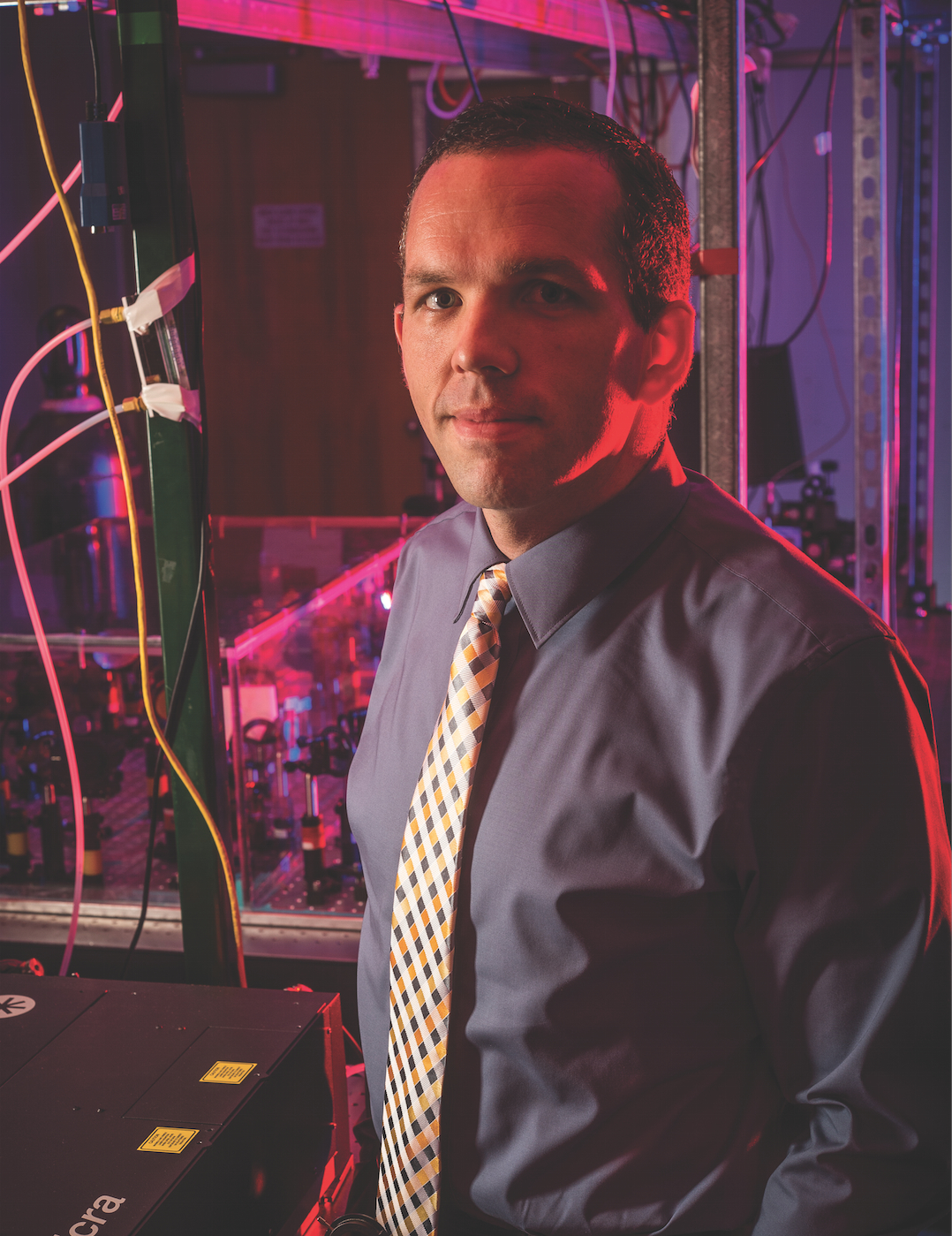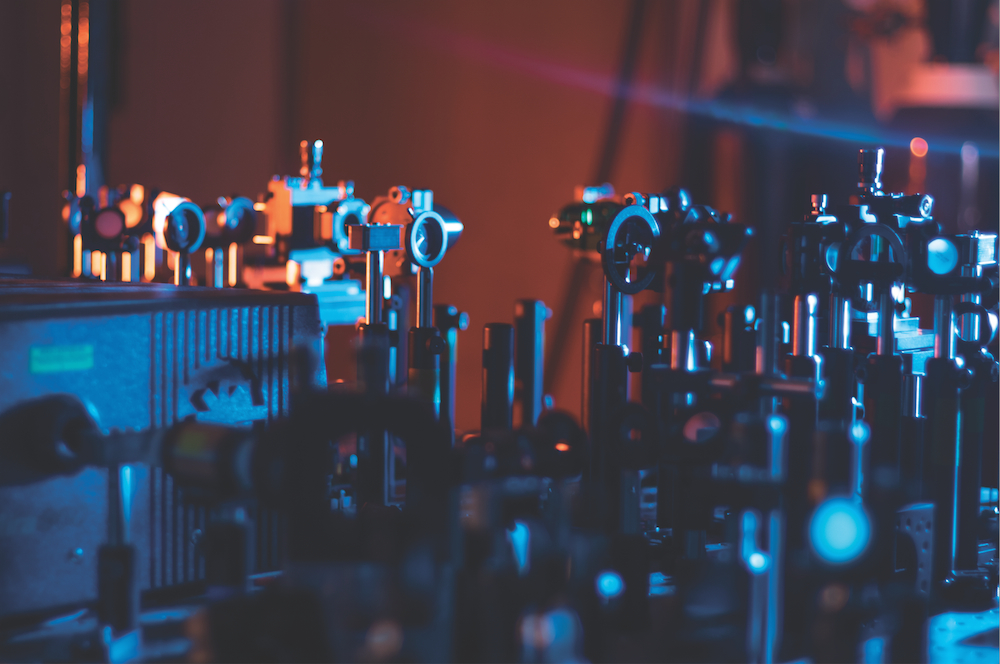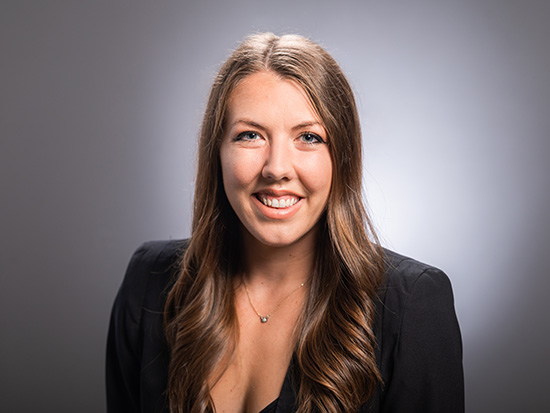What makes a student successful? Often it’s a faculty member, like Dr. David Hilton in the Department of Physics, who has guided undergraduates and graduate students to some prestigious awards and academic accomplishments.
Photos by Jared Bash“Mentorship” is a term that’s often heard in higher education, particularly in the last decade.
 David HiltonSenior faculty mentoring junior faculty, faculty members mentoring graduate students, graduate students mentoring undergraduates, the trend has been to encourage—through institutional policies, unofficial motivation, or both— a system by which the more educated and experienced senior person can guide the less experienced, less educated junior person.
David HiltonSenior faculty mentoring junior faculty, faculty members mentoring graduate students, graduate students mentoring undergraduates, the trend has been to encourage—through institutional policies, unofficial motivation, or both— a system by which the more educated and experienced senior person can guide the less experienced, less educated junior person.And by many accounts, it has been a successful endeavor. A Hanover Research study from January 2014 cites a number of takeaways for administrators looking to develop these kinds of programs. “Although the particular format of successful mentoring models sometimes varies, all programs share certain characteristics,” the study reports. “These include support from top-level administrators, integration within a more comprehensive strategy for faculty development, a voluntary participation policy, participant involvement in the pairing process, the availability or resources to assist mentorship relationships, and the establishment of clear mentorship goals and expectations.”
Within the College of Arts and Sciences, several relatively new mentorship programs have proven to be successful for participants. Our National Science Foundation CAREER Training Program pairs senior research faculty with junior faculty to guide them through the rigorous application process for an NSF CAREER Award; in the eight years of the program, the College has had six faculty members receive the prestigious designation, bringing in more than $3 million dollars to our departments for research.
In addition, our work with graduate students, including the Graduate Fellows Program that supports incoming doctoral students with stipends, has led to an increase in research productivity within the College.
But what about our undergraduates?
It turns out that here at UAB, undergraduates not only benefit from the relationships they have with older students, but from faculty members as well. In the College of Arts and Sciences we want everyone to succeed and attain their personal goals. Along with the formal instruction and evaluation processes expected for students, faculty, and staff, we strive to provide additional opportunities for personal growth and the development of leadership skills. Our mentoring programs reach all members of our College. In the case of our students, College of Arts and Sciences faculty often develop more informal, personal, relationships with students to provide guidance, feedback, and growth opportunities. The result is the incredible success our students enjoy in national award competitions, entrance to top graduate schools, and success in garnering their first position after graduation.
Many of these relationships happen organically, as professors and students bond over projects and assignments. And often, those relationships continue outside of the particular class in which the student and instructor met. Within the College, numerous faculty members stay in touch with their students, guiding them in everything from course decisions to research and papers, to internship and job opportunities.
In some cases, however, the faculty member is so adept at fostering confidence, academic success, and work quality in an undergraduate that he or she has mastered the art of mentoring.
What Makes a Mentor?
Dr. David Hilton is one such professor. A member of the faculty in the Department of Physics since 2007 and 2010 CAREER Award winner, he says he has learned over the years what makes a good mentor and what is fulfilling to both the faculty member and student. “First off, you need a big enough project that you can pull a smaller piece off, and you have to be sure that doing so isn’t going to affect the timeframe of the project,” he says. “Next, you have to identify something that the student is interested in doing, that will give them a better understanding of the subject right away, and doesn’t create a system where they’re just doing the grunt work for a graduate student. It has to be their own work, and real work.” Aidan O’Beirne, Luke McClintock, and Dr. David HiltonHilton works with spectrometers, measuring light reflection to assess the conductivity of new materials that could one day replace silicon in microprocessors. His lab features an elaborate array of lasers that validate his test models, with the ultimate goal of showing manufacturers what options would be faster and more sustainable than silicon.
Aidan O’Beirne, Luke McClintock, and Dr. David HiltonHilton works with spectrometers, measuring light reflection to assess the conductivity of new materials that could one day replace silicon in microprocessors. His lab features an elaborate array of lasers that validate his test models, with the ultimate goal of showing manufacturers what options would be faster and more sustainable than silicon.When Hilton sees positive results in his lab, he can scale up the project by taking it to the National High Magnetic Laboratory at Florida State University, one of only three magnet labs in the country. There, the powerful magnets can test the viability of the new materials Hilton and his students have experimented with on a smaller scale at UAB. “Post docs, graduate students, and undergraduates have been able to go to Florida State to continue their work,” he says. “Once they reach a certain level, they can even go on their own.”
Catalyzing Student Success
Senior Luke McClintock, who earned a Goldwater Scholarship scholarship in 2015, is one of Hilton’s high-performing undergraduates who made the trip to FSU, and with whom Hilton has built as strong relationship. McClintock says he was drawn to Hilton’s work even as a chemistry major. “I joined the Physics track because my first two general physics classes had interested me, but mostly because of my experience working for Dr. Hilton in the physics summer REU program,” he says. “I really enjoyed the science and got along with Dr. Hilton splendidly. He basically convinced me to do the double major, and then later I decided to get two full degrees.”McClintock found himself empowered by his faculty mentor early on. “When I first met with Dr. Hilton and asked him about my project, he said, ‘Your project resembles trying to hit a bullet with a bullet and both bullets are invisible.’ He is absurdly intelligent, but knows how to break things down for inexperienced people to understand. That is absolutely the most important part of good teaching. He is also good at making topics interesting, even to people who aren’t of the nerd bloodline like me.”
Hilton has pushed McClintock hard, but McClintock says that has paid off. “He is great at involving students in his work and ideas, but he expects results, which has been a good atmosphere for me,” McClintock says. “The pressure to prove I can get something done has been stressful at times, but I wouldn’t be successful without it.”
Hilton’s connections at Los Alamos National Laboratory have also been valuable to McClintock and other students, as has his own example of hard work and focus. “Good faculty mentors motivate students through examples of direct application of their work to the real world. Nobody wants to feel like their work is pointless,” McClintock says. “My work in Dr. Hilton’s lab has definitely prepared me, and I already have experience out of his lab to compare with. In no way have I been spoiled. Dr. Hilton treats me like a researcher and expects me to get things done. It is because of my training in his lab that I have been successful elsewhere and will be successful in the future.”
And, like most good investments, the returns Hilton has made in his students keep coming back. Aidan O’Beirne, a junior majoring in Physics, is following behind McClintock, working long hours in Hilton’s lab and absorbing everything he can from his professor, the graduate students, and from his friend Luke. “Dr. Hilton is happy to answer questions—repeatedly. His door is always open and he’s always available.”

Peer to Peer
O’Beirne says that Hilton’s primary concern is helping people succeed. “He has this attitude of ‘We’re gonna do it,’” he says. “That can be helping me chart the step-by-step course I need to follow to win an award, or figuring something out in the lab. He wants to give people opportunities, and he makes it okay to fail. He prepares you and lets you know it’s okay when something doesn’t work out.”O’Beirne says that, of Hilton’s many good qualities, it’s his respectful approach to students that may be his most meaningful. “He doesn’t value hierarchy; he values the people who are doing the work,” he says. McClintock agrees. “He treats me like I am a fellow researcher, as opposed to just some temporary undergrad student,” he says.
For his part, Hilton is clearly proud of his students. “They’re doing really great stuff,” he says. “They’re the real deal.”


